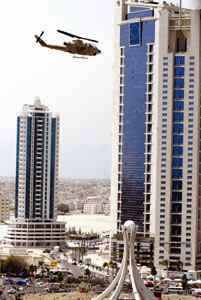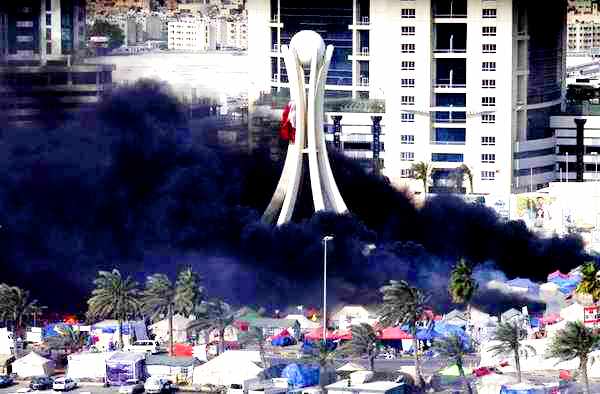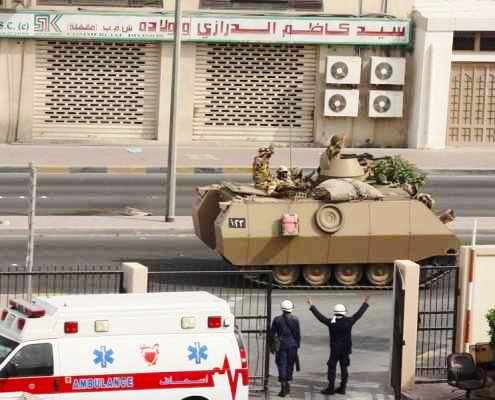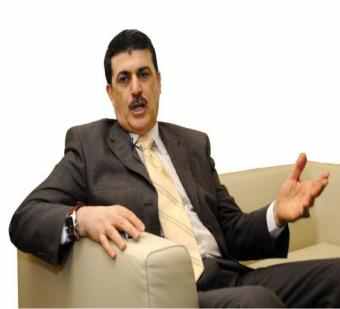Bahraini Doctors: A Thorn to the Regime -Part 7- Launching the Cleansing Phase

2011-08-21 - 9:39 ص
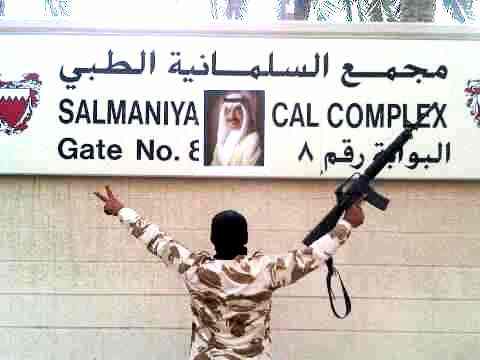 Bahrain Mirror (Exclusive): Part 6 of this report covered some of the violations that the medical staff had lived on the first day of the martial law enforcement on March 15, 2011. The Peninsula Shield troops initiated it by attacking Sitra area which resulted in two protesters being killed, a Bangladeshi national worker who tried to protect Sitra's woman was killed, and 250 protesters were injured, 65 of them in critical conditions. “I hadn't seen for my life people standing so courageously before brutal repression, as I did on that day. It was a day when fear was left behind and bravery was put forward. No difference between men and women” A member of the medical staff said. The events of that day in Sitra caused other reactions, including a number of resignations of the official state positions protesting against the violent police handling of the crisis. They were started by Mrs Nada Haffad the member of the Shura (Consultative) Council. She spoke to Al-Wasat daily about her resignation: “It was because of the ongoing of attacks on the population, and of mishandling of the issues since the start till now. Had the government resigned from the beginning, people would've been relieved and we would've walked the right path”. She wondered: “Why an army from outside Bahrain come here? Is it to protect us from our own people?” and added: “Who are those masked men who roam Bahrain and have swords and cold weapons?”. She denounced: “Why the attacks at Sitra? Who shoots at Sar and other areas? It's bad planning and handling and I don't accept that”(1). Cleansing...
Despite the criminalization of the use of the word “Cleansing” as it is considered an act of crime, and despite its religious sensitivity as it is an antonym to impurity, the regime did not hesitate to use it in its statements. It was not ashamed internationally or humanly to repeat it in its press and media outlets. Defiled Cleansing Since early morning of Wednesday March 16, the protesters in the Roundabout were preparing for the expected attack (2). At 6:00 AM all the cell phones communications were suddenly disrupted. "We tried to contact the youths to inquire about the situation there, but there was no connection". Then, the attack took place. Troops from the army, public security, and the National Guard surrounded the Roundabout. Apache helicopter warships were hovering over the Roundabout and firing live bullets at the protesters (3). Helicopters were flying everywhere. Columns of the army troops marched in the streets to confront the unarmed protesters (4). The streets around the Roundabout were completely closed by army tanks and armored vehicles. The snipers deployed on the top of the buildings (5). A young man recalled: "We tried to reach the Roundabout, the streets to it were completely closed, we went through Noaim side and we saw security forces and army troops were crowding on the roofs of Noaim Police Station. They were pointing their guns at whoever passes toward the Roundabout. It was horrible. We returned”. At the Roundabout, some protesters fled toward the nearby houses, but some of them held steadfast for the longest possible time before the army and security forces succeeded in taking hold of the Roundabout after the attack got more intense. The unarmed youth braved long confrontations in front of the army vehicles. A video clip shows a number of the unarmed youths talking to the police : “We don't have weapons why are you attacking us by tanks?” (6). The withdrawal of protestors was not as easy as it was portrayed in the army statement. The youths who blocked the bridge overlooking the roundabout to prevent the army troops from reaching them, stood on the bridge and started banging on the steel bars protestingly. The forces came on foot from under the bridge and fired tear gas at them, rubber bullets and birds gunshots (7). Chases ended in the fall of a large number of injuries who were denied ambulances (8). They were prevented from reaching Salamaniya Hospital which was besieged by security forces and army vehicles. The injured were transported in private cars to Noaim Health Center which was close to the Roundabout, to the Bahrain International Hospital (9), and to Ibn Al-Nafees Hospital that opened to receive the injured. On that day, Jaafar Salman (41 years) from Karranah village fell dead, as well as Ahmed Abudlla (23 years) from Hamad Town. Their death was proclaimed at Bahrain International Hospital (10). While the third victim was Jaafar Mayoof (30 years) who was proclaimed dead at Ibn Al-Nafees Hospital. Later on the day a live bullet killed an Indian who worked as a watchman in a company in Hajar area. A helicopter was hovering in that area. He continued to bleed for an hour and a half without treatment until he died. Al-Wefaq political society announced that thirty people were missing and nothing was known about them. An observer noted: “The army that never knew a real battlefield had its first experience to test its skills in attack, occupation, destruction, killing, tyranny and deadly engagement. It didn't leave anything it could bring to use on that day. Its battlefield was Sitra, the Roundabout and Salmaniya Hospital”. The army carried out the cleansing order and entered an unholy war. One party in its full gear confronted. The other completely unarmed. The army strived in a battle, the disgrace of which it will bear forever. It was a profane war. Absent Regime Loyalists
A large number of doctors and medical staff spent their previous night sleeping in the hospital expecting emergency cases. “Everything indicated that on that day they would attack the Roundabout”. However, another number of doctors stopped attending hospital two days before it was besieged. Dr. Isa Al-Shurooqi the training coordinator at the Ministry of Health, sent some of the doctors loyal to the regime to the Military Hospital which the injured later would be transported to, and other staff were sent to the new King Hamad Hospital, which was not ready then. However, its Emergency Department was opened and equipped only two days before the attack on the Roundabout and besieging of Salmaniya Hosptial. It revealed the plan of transporting the injured to those hospitals rather than Salmaniya Hospital. It was published in the official newspapers: “The Emergency Department at King Hamad University Hospital has been made ready with the assistance of the Medical Services of Bahrain Defence Force that supplied us with the medical equipment, a long with five ambulance. Doctors and nurses were ready and the operation room was equipped in a record time” (11) . That was a prelude to the brutal attack that was being prepared. The plan was to put the medical staff and Salmaniya Hospital under the full control of the authorities while the attack took place, to prevent it from becoming again, as it did during the events of February 17, a channel to expose the real face of a regime that harped falsely the songs of democracy and civilization. That way it ensured that the injured would be in the grip of the military. The doctors were unable to treat the injured, and most importantly to ensure the prevention of scandals. Another number of the medical staff loyal to the regime took sick leaves on those particular days. In a word, the hospital was empty of the doctors loyal to the regime, except for the administrative staff. That way they ensured the absence of those whom they wanted to protect and kept those whom they wanted to abuse. Before two days a decree from the Ministry of Health was issued to erect a medical tent at Salmaniya Hospital courtyard. A large tent was erected and provided with medical equipment and supplies. They had just been made ready one night before the attack on the Roundabout.
Above the hospital a helicopter flew at low altitude, "a sniper was aiming his weapon toward us from the helicopter" A female doctor testified. She added: "I was standing with a number of the medical staff at the entrance of the Emergency Department, when a helicopter hovered over our heads at low altitude and threw a stun bomb toward us". The medical staff, terrified, fled into the hospital building. The Grip of the Military In the upper floors of the hospital, the medical staff lined up to watch gloomily through the windows what was happening at the Emergency Department courtyard and the adjoining parking lot. The security and army troops started immediately attacking the tents that were erected by the protesters, and the medical tent that was only equipped with medical equipment hours ago. It was smashed completely with all its contents and equipment, which were all a state property. "I've never seen for my life soldiers fighting tents and medical equipment but the Bahraini and Saudi armies" A female doctor said. The medical staff held their cell phones filming what was going on. The troops saw them from below, they aimed their weapons toward the glasses of the upper floors, message received, and filming stopped. Another group of soldiers and anti-riot police went to the car park and started immediately breaking some of the cars. A female doctor remembered: "We saw them put things inside some cars, we didn't know what they were, then they started filming with TV cameras. Then we saw them break the door of the Gulf University opposite to the car park, they put things there that we weren't able to distinguish, they filmed that too". At the same time, a number of officers entered the hospital through the Emergency Department and took control of the administration. They declared a military administration led by Dr. Fatiha (of Egyptian origin) who would later lead the interrogation of the doctors. Under-secretary Mariam Al-Jalahma, under-secretary Ameen Al-Ssaati and other administrative staff including Ahmed Al-Am were present. The latter was believed to have strong connections with the Public Security, army and intelligence officers. A female doctor recalled: "As if everything was over in a moment, and death was coming, and after it a complete darkness. That was my feeling at that time". She continued: "We were waiting for an attack on us after smashing everything in the courtyard below. I was asking myself: Was everything over? Was it our turn then?". No one asked the other, no one answered. The communication was intermittent and weak, but they kept receiving the news. They heard about the injuries and the cases at the Roundabout and Sitra area. Sitra remained for the second day under a continuous barbaric repression. People did not know where to take their injured. They went to the Health Centers and some of the private hospitals that accepted to receive the cases e.g. Bahrain International Hospital, Ibn Al-Nafis Hospital and the American Mission Hospital. The medical staff realized that their presence at the hospital was useless as they were prevented from saving lives. But what to do? Totalitarian Cleansing
“The view of vandalism in the parking lot outside the Emergency Department was alarming, we didn't believe what we saw. It was like a dream”. The army besieging the Medical Complex campus wall was busy with another mission. It changed the watchmen at the entrances of the hospital and prevented any entry or exits. It had another cleansing mission; smashing all the cars parking along the Salmaniya Medical Complex perimeter. “On the day I left the Medical Complex I saw a graveyard of smashed cars everywhere, I tried to find an untouched car, but couldn't find one” A female doctor said. Hundreds of cars were smashed, and then towed away after few days. Their owners were forced to sign waivers against any future claims for them. The same thing happened to all the cars that were parked at the vicinity of the Roundabout. It was part of what the military statement of the cleansing of the Roundabout and the hospital and evacuating the outlaws. The cars that helped the protesters arrive there were outlaws and should be disposed of. As well as the Pearl Roundabout was an outlaw when it allowed the protesters to sit-in. So cleansing took place and the Pearl mounemount was hastily demolished on Friday March 18th, just after two days of the attack. The Minister's Resignation A number of the medical staff asked the Minister to provide protection and allow them to leave in the ambulances to treat the injured in Sitra area. At that time, the Roundabout was evacuated, while Sitra was still burning with army bullets. The Minister Al-Baharna coordinated with the military administration and accordingly he gave his assurance to the medical staff that they could leave with the ambulances without being harmed. They were given permission to leave through the back gate that was opposite to the Sana markets building. They got ready to leave, and eventually were allowed to leave through the back gate. The police TV cameras were filming the ambulances while they left safely. They were shown on Bahrain TV to prove that the ambulances were not prevented from leaving. But did they leave safely? “They allowed them to leave through the gate so that Bahrain TV filmed the scene and immediately aired it, to say to the world that they allowed the ambulances to leave, but as soon as the ambulances crossed the gate they attacked them” A female doctor said. Outside the back gate, the ambulances were stopped and the medical staff were taken down and interrogated and were asked whether they were Shia or Sunni. They started beating up brutally all the medical staff in one of the ambulances, after they had been insulted and sworn at. The attack resulted in a hand fracture of one of the medical staff. Soon that ambulance returned to the hospital, for its staff to receive treatment rather than leaving to offer it. “I was stunned by seeing the traces of the troops boots on every part of the young doctor's body who left with the ambulance. His face was soiled by sand as well as his hair and all his clothes” A female doctor said. The medical staff who were attacked included Dr. Ahmed Al-Omran. Another ambulance was attacked, it had both the Hospitals CEO Walid Al-Manea and the former head of the Ambulance Department Mohammed Abdulraheem. Another ambulance continued its way to Sitra area amid numerous checkpoints stops. But when it reached Sitra the troops completely surrounded the area and the roads were deserted. The army with semi-automatic guns closed the main road leading to Sitra. It was the cleansing; “We only found ruins in a road that was consumed by shelling” a female of the medical staff said. Back in Salmaniya, at Gate No. 1 everyone saw three young men, but no one was able to recognize them. Their hands were tied behind their backs. They were being abused, beaten, and tortured without anyone being able, including the Minister himself, to help them or do anything for them. The Minister Al-Baharna witnessed all what happened; the ordeal that the medical staff went through when they were allowed to leave under his protection and after permission form the Ministry and the new Military Administration and what happened of sabotage, intimidation and abuse in the hospital. He stood in front of the military officers (among them was a military officer from the ruling family) and announced his resignation in protest of the trampling of the honor of the Ministry, the Minister, the hospital, the humanity, and the state. He protested the fall of all honor under the boots of the military.
| ||||||||||
اقرأ أيضا
- 2024-07-10Bahraini Authorities Summon Head of Sanabis Ma'tam, Threaten "Actions" Due to Mourners' Chants Against Israeli Occupation
- 2024-07-10Political Prisoner Mohammad Al-Raml's Family Say He's Vomiting Blood Due to Poor Conditions, Fear for His Life
- 2024-07-09Ali Al-Majed Arrested After His Return to Bahrain
- 2024-07-08Yusuf Al-Muhafdha: Convicted Returnees to Bahrain Have the Right to a Lawyer, Retrial, and Legal Guarantees
- 2024-07-08Reciter Mahdi Sahwan: Head of Manama Police Informed Me of Ban on Reciters Traveling to Commemorate Ashura
